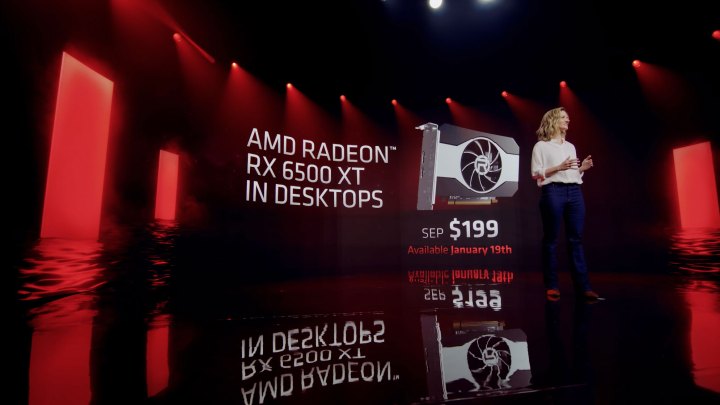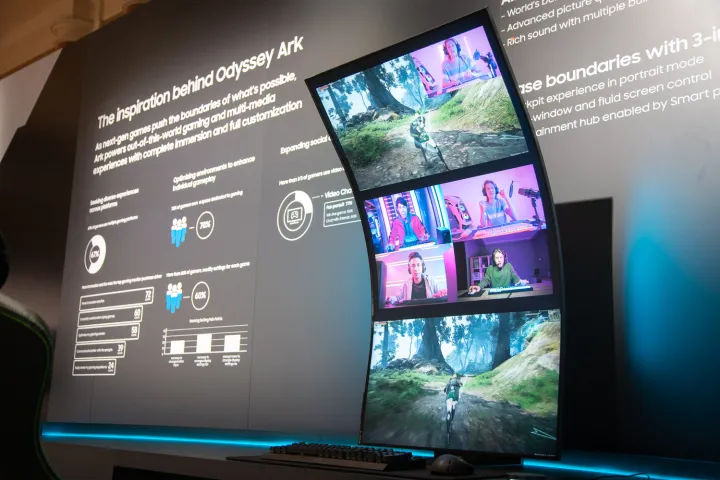January was a massive month for PCs. Starting with the biggest tech event of the year, we have seen new graphics cards, laptops, monitors, and everything in-between. January was a month of new products, but also of unprecedented levels of controversy, and these eight new stories show that.
We rounded up the most important news stories from January 2022 so that you can get up to speed on all of the announcements you may have missed.
The RX 6500 XT is actually a laptop GPU

Budget graphics cards were set to make a comeback after CES 2022, spearheaded by AMD’s $199 RX 6500 XT. It was set up for success. AMD said the card was capable of the highest sustained clock speeds ever, and it was the first time Team Red was using a 6nm manufacturing process on a desktop graphics card.
But then our hopes came crashing back down to Earth. The card performs terribly, even considering its list price. Graphics cards that are three or even four years old perform better in many cases, despite costing less on the secondhand market. The situation is so bad that we rounded up three graphics cards that are better than the RX 6500 XT, and some of them are nearly five years old.
The climax to this story is the revelation that the RX 6500 XT is actually a laptop GPU. An AMD employee took to the Phoronix forums to explain that the RX 6500 XT was designed to go with AMD’s new Ryzen 6000 mobile APUs, which explains all of the nonsensical design decisions AMD made. Yikes.
Folding laptops make a comeback

CES 2020 was supposed to be the year of folding laptops, with Lenovo debuting the first foldable laptop ever. Two years later, folding laptops are making a comeback in a big way. Intel recently unveiled a foldable display specification for laptops in 2022, and some designers have machines already working.
One of those machines is the Asus Zenbook 17 Fold, which we had a chance to demo earlier this month. It’s a great concept, but it’s still not ready for prime time due to a number of frustrating design compromises. While 2022 may be the year of folding laptops, folding laptops still need to learn from the mistakes of folding phones, as Andy Boxall, our Senior Mobile Writer, points out.
Samsung knows those mistakes all too well, which is why we’re especially excited about the Samsung Flex Note. It’s still a concept right now, but the machine looks to take the knowledge Samsung has with foldable phones and apply it to a laptop. We don’t have information about the machine yet, but hopefully it’ll arrive this year.
Intel expands 12th-gen Alder Lake

Intel launched its 12th-gen Alder Lake platform last November, but only in spirit. We had a shockingly low number of CPUs at release, led by the Core i9-12900K. January was when Intel expanded 12th-gen Alder Lake to mobile and filled out the rest of the desktop range.
We had a chance to test out the flagship mobile chip later in the month. The Core i9-12900HK is the fastest mobile processor we’ve tested, easily beating out Apple’s M1 Pro and AMD’s competing Ryzen 9 5900H. Intel announced that 12th-gen Alder Lake processors will be available in over 100 laptop designs by the end of the year.
That’s great, but the news is soured a bit by Intel’s other announcement in January: More 12th-gen desktop CPUs. There are some standouts, but most of the new desktop processors ditch the hybrid architecture that made Alder Lake so impressive to begin with.
No one asked for this: The RTX 3090 Ti

Nvidia announced two new graphics cards at CES 2022: The RTX 3050 and RTX 3090 Ti. The RTX 3050 is a great budget GPU, but the RTX 3090 Ti? No one asked for this card we still know precious little about, including when it will launch and, critically, how much it’ll cost.
There are hints, though. January brought rumors about MSI’s Suprim X version of the GPU, which is said to cost as much as $4,500 and require a 1,000-watt power supply. That may not be true, but we’ve already seen half a dozen rumors about the RTX 3090 Ti drawing 500W of power or more.
We’re not eager for a new halo product when it’s still so hard to find midrange graphics cards in stock. Reports suggest that Nvidia has halted production of the RTX 3090 Ti, so we may not hear more about this graphics card for a while.
Samsung hits big with displays

Samsung won CES this year with the announcement of the Samsung ARK. It’s a 55-inch QD-OLED gaming monitor with a unique twist: A stand that allows the display to go fully vertical. We saw the monitor at the show, and it’s the ultimate gaming display. The form factor is interesting, but the included wireless control dial enables multitasking, different aspect ratios, and picture-in-picture.
The ARK is so impressive that it overshadows another amazing feat Samsung achieved this month: 4K at 240Hz. We saw a dozen 4K monitors with high refresh rates at CES, but the Samsung Odyssey Neo G8 blows all of them out of the water. It’s the first 4K display with a 240Hz refresh rate, and it sets a new standard for high-end gaming monitors.
Samsung announced a suite of other products in January, including Gaming Hub that can launch popular gaming apps directly on your TV or monitor.
Nvidia forgets about the 12GB RTX 3080

Nvidia announced the RTX 3050 and RTX 3090 Ti in January, but a third GPU arrived last month, too. The 12GB RTX 3080 silently launched a week after CES, as if Nvidia forgot to mention that it was launching a new flagship at the biggest tech event of the year.
There was a reason for that. Nvidia silently launched the card without any day one reviews, and although Nvidia didn’t set a list price, board partners are selling cards for much more than the base RTX 3080. That’s not good considering we didn’t find a big performance improvement in our 12GB RTX 3080 review.
It seems this 12GB model was a way to raise the base price of the RTX 3080 after the GPU shortage ends. Compared to the 10GB model, which is hundreds of dollars cheaper in many cases, the extra video memory doesn’t do much for performance.
Dell messes with a fan-favorite design

It’s no secret that we like the Dell XPS 13 here at Digital Trends. It has consistently held the crown for the best laptop you can buy. But Dell messed with the design this month. The Dell XPS 13 Plus invites controversy with an aluminum finish around the body, no headphone jack, and a function row composed entirely of capacitive touch buttons.
The new design is a departure for what has been the go-to thin-and-light laptop over the last several years. Our resident laptop expert, Mark Coppock, argues that the changes are for the best, allowing Dell to innovate on a product that has become stale over the past few releases. We just have to wait for now, though. The XPS 13 Plus is expected to arrive in the first few months of 2022.
Nvidia’s ARM deal is all but dead

In 2020, Nvidia announced that it planned to purchase chipmaker ARM for around $40 billion. ARM is behind the chip designs in hundreds of billions of devices, including most phones and smart home products. After announcing the acquisition, Nvidia was met with a string of antitrust probes, climaxing with a lawsuit in December 2021 from the Federal Trade Commission (FTC).
That lawsuit may have been the final nail in the coffin. This month, sources confirmed that Nvidia is abandoning the deal with ARM. Nvidia hasn’t made any announcements, but with reports of the company deserting the deal and a pending lawsuit, it may be dead.
Editors' Recommendations
- Does RAM speed matter for PC performance?
- As a lifelong PC gamer, these are the apps I couldn’t live without
- Everything you need to know about buying a GPU in 2024
- I’ve reviewed every AMD and Nvidia GPU this generation — here’s how the two companies stack up
- You shouldn’t buy these Nvidia GPUs right now





